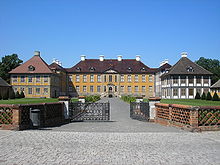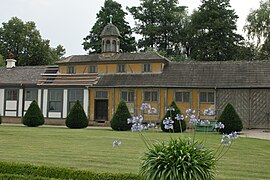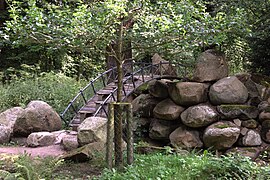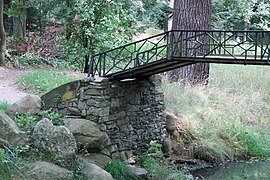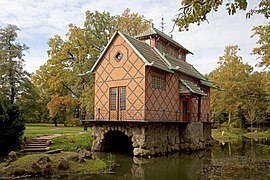Oranienbaum Castle
The Oranienbaum Palace is located in the town Oranienbaum-Wörlitz in Saxony-Anhalt . It belongs to the Garden Kingdom of Dessau-Wörlitz .
geography
The castle , which is located in the Oranienbaum district, is east of Dessau-Roßlau , only a few kilometers from Wörlitzer Park .
history
From 1681 to around 1685, the castle was built in an initial construction phase, initially as a summer residence for Princess Henriette Catharina , wife of Prince Johann Georg II of Anhalt-Dessau and born Princess of Orange-Nassau . The Dutch builder Cornelis Ryckwaert , who works in Brandenburg, was commissioned with the construction . Initially, only one has been Palais with Cavalier pavilions built and a 28 hectare large baroque garden created in the Dutch style. A moat separates the inner semicircular garden ground floor from the outer one, which has retained its geometric structure. At the same time, Ryckwaert had the city of Oranienbaum built on a geometric floor plan. The princess, who had Dutch business acumen, had a glassworks built in 1669 and a brewery in 1693, and tobacco was grown in Oranienbaum since 1693.
After the Prince's death in 1693, Oranienbaum was rebuilt as a widow's residence for Princess Henriette Catharina to become today's three-winged palace (1698 to around 1702). The staggered side wings look Dutch. A rich interior with precious leather wallpaper , faience and paintings gave the house its shine, which is still evident today in the tiled cellar, the leather wallpaper hall and the mirror crystal hall with its unusual modern objects by the Dutch glass artist Bernhard Heesen. The portrait gallery of the Askanians , paintings from the “Orange Inheritance” (which can still be seen in parts in Mosigkau Castle today ) and the collection of paintings from the dissolved Amalienstift adorned the castle until 1945. The summer dining room with Delft ceramic tiles is located in the basement .
After the death of Henriette Catharina in 1708, the baroque town church was completed in 1712. From then on, the castle was only used occasionally for hunting by the princes of Anhalt-Dessau . Only Prince Leopold Friedrich Franz von Anhalt-Dessau, the creator of the Dessau-Wörlitz park landscape , showed more interest in Oranienbaum Castle again. He had the palace and park redesigned after 1780. Numerous rooms were given new furnishings in the Chinese style, whereby the wall paintings remained partially fragmentary. The former baroque island garden was redesigned from 1793 to 1797 according to the ideas of the English landscape gardener Sir William Chambers to become the only English-Chinese garden still largely preserved in Germany , with a five- story pagoda , a Chinese tea house that can be accessed from the water and several arched bridges .
The 175 m long orangery , one of the largest in Europe, was built in the southern part of the garden in 1811 and has since been used to house a large collection of citrus plants and other rare woody plants without interruption.
After the Second World War , the GDR housed a branch of the Magdeburg State Archives in Oranienbaum Castle from 1953 . In 1993 this branch was upgraded to the independent State Archives Oranienbaum. At the beginning of the 21st century, the archive moved to Dessau . The castle was then opened to visitors in 2003. Completion of the restoration work on and in the castle is currently not foreseeable. However, the rooms open to the public already give an impression of the former splendor of the palace furnishings.
On March 3, 2004, Queen Beatrix of the Netherlands visited Oranienbaum Palace to find out about the progress of the restoration work in her ancestor's palace.
The ensemble of town, palace and park Oranienbaum, built on a geometrical floor plan, is today a rare example of a predominantly Dutch-influenced baroque complex in Germany.
The castle can be visited for an entrance fee. The castle park is freely accessible, the restored pagoda and the tea house are accessible after registration. In the orangery are u. a. a café and a carriage exhibition. There is a large citrus garden next to the orangery. (Last updated 2012)
Connection to today's royal family of the Netherlands
Oranienbaum Castle is one of four castles in Germany named after the House of Oranien . They were built for four sisters, daughters of the Dutch governor Friedrich Heinrich Prince of Orange-Nassau and his wife Amalie zu Solms-Braunfels , who were married to German rulers. In addition to Oranienbaum, these are Oranienburg Palace near Berlin (for Luise Henriette von Brandenburg), Oranienstein Palace near Diez (for Albertine Agnes von Nassau-Dietz) and the - no longer existing - Oranienhof Palace near Bad Kreuznach (for Marie von Pfalz-Simmern).
The former Dutch Queen Beatrix is the patron of the restoration of the Oranienbaum Palace. In 2004 and 2012 Beatrix visited Oranienbaum and inspected the castle.
gallery
See also
literature
- Katharina Bechler: Oranienbaum Castle. Architecture and Art Policy of the Orange Women in the Second Half of the 17th Century. Mitteldeutscher Verlag Halle (Saale) 2000.
- Hans-Joachim Böttcher : Oranienbaum - Princes strolling under the trees ..., in: Quiet and full of bitter beauty ... Palaces and their gardens in the Dübener Heide , Bad Düben 2006, pp. 221–236, ISBN 978-3- 00-020880-5 .
Web links
- Orangery Oranienbaum Accessed: May 2, 2010
- official page
Coordinates: 51 ° 47 ′ 59.8 " N , 12 ° 24 ′ 12.8" E
